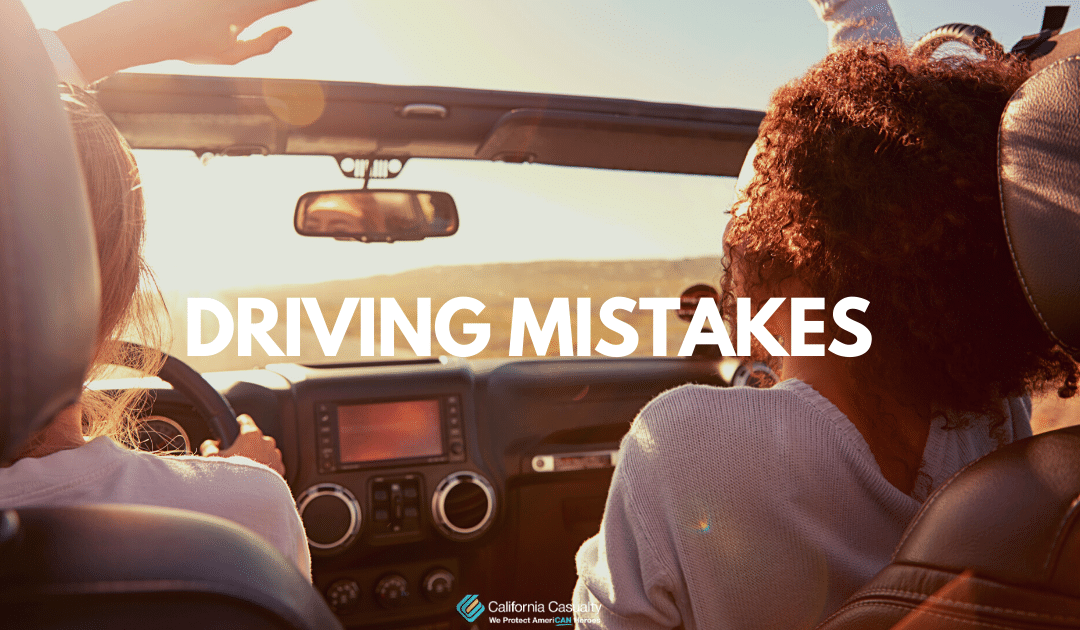Our streets and freeways are coming back to life after having been empty for months. Now that we’re all getting back on the road, we’re getting re-acquainted with driving etiquette, traffic laws and sharing space with other drivers . . . which makes this a great time for a safe-driving refresh.
Here are 10 top driving errors and how you can easily correct them.
- Incorrect Speed
DON’T: drive too fast or too slow. Drivers often go faster than the posted speed limit (which is incredibly dangerous near schools and in residential areas) or drive too fast in extreme weather conditions or congested traffic. On the flip side, driving well below the speed limit can cause unsafe conditions for you or other drivers.
How to Correct: Make sure to abide by speed limits and also adjust speed according to your specific environmental conditions.
- Improper Lane Changes
DON’T: make unsafe lane changes. Changing lanes without double-checking for other vehicles can often lead to disastrous results. Blind spots, speed, and distraction all increase the risk of a collision.
How to Correct: Make it a habit to check mirrors, use turn signals, and do a full head check before changing lanes.
- Following Too Closely
DON’T: tailgate other cars. In the event of a stop or crash, there is not enough reaction time to avoid a crash.
How to Correct: Always stay several car lengths behind the traffic in front of you. A good rule of thumb is the 3-second rule. Using a fixed object as your guide, count the number of seconds (one-one thousand, two-one thousand…) between when the car in front of you passes it and you pass it. Add extra time in unsafe weather conditions or when roads are slick.
- Improper Turns
DON’T: avoid turning too wide. When you turn wide from the middle of the road, you risk colliding with pedestrians, bicyclists and other cars on the right.
How to Correct: To make a proper turn, use your turn signal about 100 feet before the turn and hug your car to the right as you slow your speed and complete the turn. This two-step process alerts other drivers around you and prevents others from moving in between your car and the curb.
- Passing Errors
DON’T: pass another vehicle within 100 ft of a railroad crossing or intersection, on a hill or curve, if you are in a “no passing” zone, or if there is oncoming traffic.
How to Correct: Passing another vehicle requires extreme caution, as you are briefly in the lane of oncoming traffic. To pass correctly, first make sure you have a long clear sightline of the other lane and that it’s free of oncoming traffic for a safe distance. Once you pass, don’t turn back into the right-hand lane until you can see the entire vehicle you just passed in your rearview mirror.
- Right-of-Way Violations
DON’T: assume you always have the right-of-way. Forty percent of all crashes involve intersections, so it’s prudent to use caution every time you approach and cross an intersection.
How to Correct: Make sure you fully stop at stop signs, obey the signals, and yield properly. Whenever there are other cars, be sure to scan the intersection — look left, straight ahead, right, and back to the left again. This gives you the time and visibility to pass safely through the intersection.
- Sudden Stops
DON’T: slam on your brakes, unless there is a valid reason.
How to Correct: Practice defensive driving and stay aware of your surroundings. Remember that any sudden movements will create a chain reaction behind you, and no one is anticipating your moves. To avoid any surprises, make sure to watch the road for pedestrians, animals crossing, or debris. In the event of an emergency, pull off to the shoulder and turn on your hazards.
- Riding the Brakes
DON’T: keep your foot on the brake while you are driving.
How to Correct: Keeping an overanxious foot on the brakes can create a “little boy who cried wolf effect” — making the driver behind you stop paying attention to your taillights and increasing the chance of a collision. Riding the brakes also wears them out much quicker. Save your breaks and ride smart.
- Not Using Your Turn Signals
DON’T: ignore your turn signals. Turn signals are an important safety feature that alerts other drivers of our intention to turn or change lanes. This gives them time to react safely, gives you the space you need to move and just generally be alert to a situational change.
How to Correct: Use your turn signals every time you are behind the wheel.
- Leaving the High Beams On
DON’T: drive with your high beams inappropriately. Incorrect use of high beams can be extremely dangerous. They can temporarily blind the drivers in front of you and those in oncoming traffic.
How to Correct: Limit the use of high beams to situations where you need them — on dark roads that have infrequent traffic, turn them off as soon as you see oncoming headlights, and remember never to use them in foggy or snowy conditions.
Soon enough, it’ll feel like we were never away from our cars and roadways. But while we’re here — getting back to our driving “normal” — it’s a perfect time to re-incorporate those safety basics back into our driving practice.
This article is furnished by California Casualty, providing auto and home insurance to educators, law enforcement officers, firefighters, and nurses. Get a quote at 1.866.704.8614 or www.calcas.com.
- Graduation – When to Remove Your Child from Your Auto Policy - May 18, 2023
- How to Prevent Catalytic Converter Theft - May 17, 2023
- How Much Does Home Insurance Cost? - May 17, 2023

